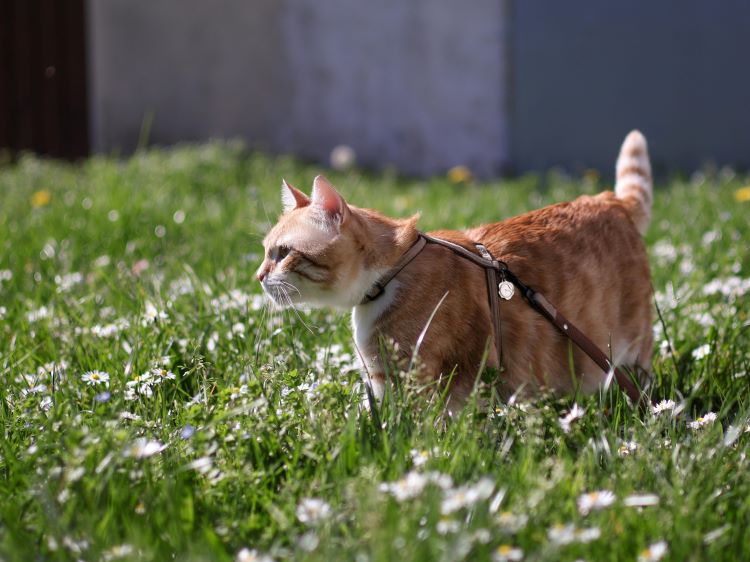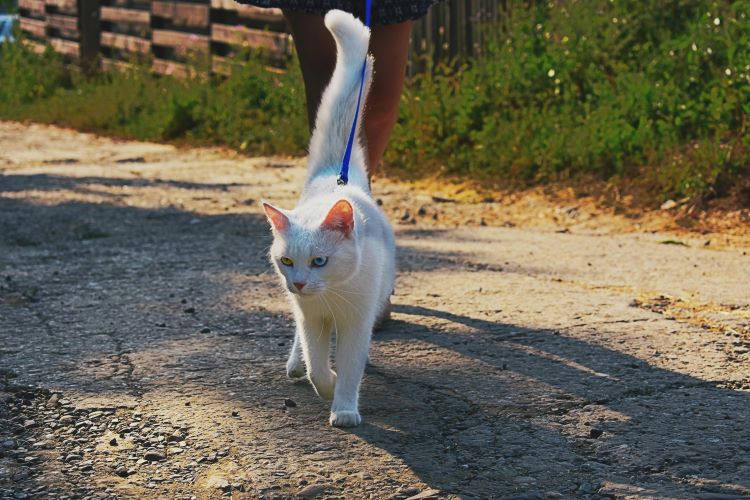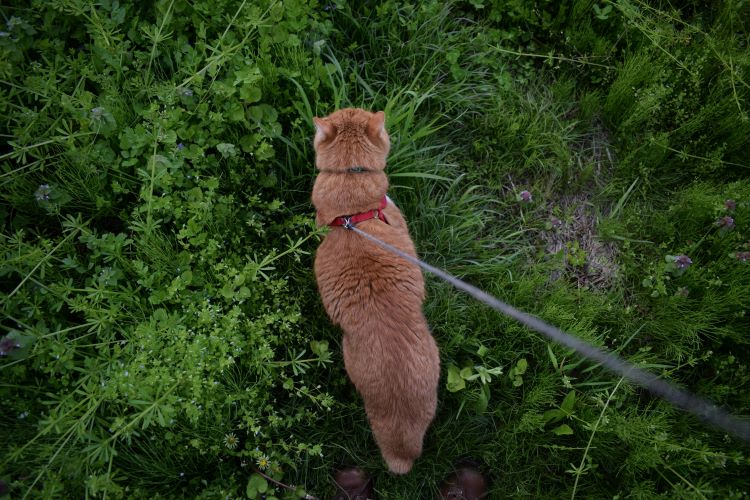Ready to help treat your pet to a healthy life?
Tips for Teaching Your Cat to Walk on a Leash
By : Kelli Rascoe & Trupanion Staff | Updated Jun 17, 2025

You know your cat needs daily exercise, and you’ve spotted them spending long hours gazing out the window at the outside world — could taking them for a walk fulfill multiple needs?
While it may seem unconventional, many cats can learn to enjoy leash walks with patience and positive reinforcement. Done right, leash training can become a bonding activity that stimulates your cat's senses and satisfies their natural curiosity, all while providing them with some much-needed exercise and enrichment. And, unlike letting your cat roam all by themselves, walking them on a leash helps keep them protected from potential dangers in the environment.
Is leash training actually possible with cats?
Just about everyone knows that leash training is an important part of having a dog, but walking one’s cat on a leash can still be a bit of a social taboo. Many cats are indoor-only due to safety concerns, and those that are allowed outdoors are typically allowed to free roam. While many cats can and do live perfectly happy lives as indoor pets, a lot of pet parents feel bad keeping their cats stuck inside. The good news is your cat may not see things this way, but bringing them outside on a leash can nevertheless offer them more daily adventure and stimulation without putting their safety at risk.
Cats are intelligent, and they can be trained to do a variety of things. Training your cat to walk on a leash calmly and safely may not come as easily as leash training a dog, but with time, patience, and consistency, it can be done!
That said, not every feline friend may take to leash training. This is especially true for older cats who are used to having free roam. Introducing a leash may seem like no big deal to you, but it can be a major lifestyle change for your pet.
Pros and cons of cat leash training
As naturally territorial creatures, cats love to explore and preside over their domain. This can mean some positives and negatives of training your cat on a leash. Now, keep in mind that bringing your cat out on walks is not considered a mandatory part of cat ownership, as there are many other ways they can get daily exercise and enrichment. But if you are interested in doing so, it’s a good idea to evaluate the pros and cons first:
Pros
- Safe outdoor exploration — Walking on a leash allows cats to enjoy the outdoors without the dangers of traffic, predators, or getting lost.
- Mental stimulation — Walks provide new sights, smells, and sounds, as well as keep indoor cats mentally enriched.
- Physical exercise — Walks can help fulfill daily exercise needs for cats, helping prevent obesity and boredom-related behavior.
- Bonding time — Leash training is a shared activity that can strengthen the connection between you and your cat.
- Travel prep — Getting pets comfortable with harnesses and leashes can help make future vet visits or traveling with your cat easier.
Cons
- Training takes time — Not all cats adapt easily to being on-leash, and training can be slow.
- Stressful for some cats — For sensitive or skittish cats, being on leash or being around outdoor stimuli can be overwhelming.
- Risk of escape — Ill-fitting harnesses can lead to escapes if the cat panics, especially if proper training steps are not followed.
- Limited control — Unlike dogs, cats may freeze, resist, or go their own way. In many cases, it’s more meandering with your cat rather than an actual walk.
- Environmental hazards — Even on a leash, cats may encounter dogs, loud noises, or toxins (like lawn treatments), so you’ll still need to keep a close eye on them.

5 tips for teaching a cat to walk on a leash
If you hope to successfully teach your kitty to be comfortable on a leash, following these tips is essential.
1. Start young
If you’re going to commit to the task of walking a cat on a leash, it’s incredibly important idea to consider your cat’s age. The younger you start your cat leash walking, the easier it will be to get them used to it. It’s also easier to establish new routines and create a pack mentality with kittens than it is with an older, already very independent feline.
2. Use a leash and harness designed for cats
There may be some small leashes and harnesses for dogs that look like they’ll fit your cat just fine. But keep in mind that, not only are cats shaped a bit differently, but they’re more limber too. Not only do you want to keep the experience comfortable for your cat, but you don’t want them to escape either. So, make sure you get a harness that is rated for cats as well as your particular pet’s size.
As for leashes, a cat leash is typically looser than a dog’s to provide opportunities for your cat to roam the area around them. Unlike dog walks, cat walks are less about control or keeping up pace and more about safe exploration.
3. Start practicing leash training indoors
Before you attempt any kind of outdoor adventure, you’ll want to get your cat accustomed to being on leash. This is for their own safety. Start by getting them used to wearing a harness around the house. You can do so by putting it on them for short periods of time, gradually increasing. Only add the leash once your pet is perfectly comfortable with the harness (this means not trying to bite it or wriggle out!).
Practice with them on the leash by going for short walks around your home, gently leading your cat in different directions. Don’t yank on them or react harshly if your cat doesn’t respond right away — the last thing you want is to create a negative association with leash training.
4. Use positive reinforcement
Any successful training for cats (or dogs, for that matter) involves creating a positive association for your pet with what you want them to do. So, when training a cat to walk on a leash, be ready to reward your pet with plenty of verbal praise as well as small treats.
5. Stay close to home
Yes, taking your cat out on a leash is about safe adventures. But especially during early training, sticking close to home is important in order to avoid overwhelming your pet. Once your cat is comfortable in a harness and on leash indoors, begin taking them just outside. Stay in your yard (if you have one) or in a close perimeter by your door. Gradually increase the distance as they grow more confident.
Still, be wary of bringing your cat on long-distance walks even when they are totally comfortable on leash. Your cat could still become easily spooked by something new, and they’re more likely to just want to amble and explore as it is. Feel free to switch up your route from day to day, but continue staying close to home.

Alternatives to leashes for cats
As we mentioned earlier, not every cat is going to take to leash training. It’s important to not force things if your cat really isn’t having a good time. Some cats may simply be happier (and safer) staying indoors. Another option is to try bringing your cat out in a cat backpack, or investing in a catio (an enclosed cat patio).
Before you try any new adventure or training with your cat, be sure to talk with your veterinarian for further advice (and to make sure your feline is healthy for new activities). It’s also worth protecting your pet with cat insurance, since you never know what kinds of surprises could come your way.
And to keep all your journeys as drama-free as possible with your pet, here’s how to get a cat into a carrier properly.
